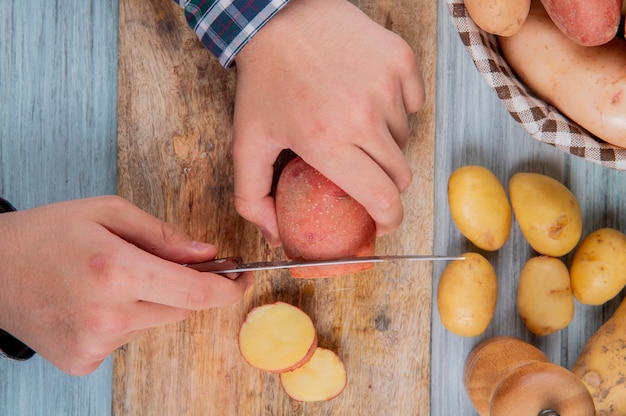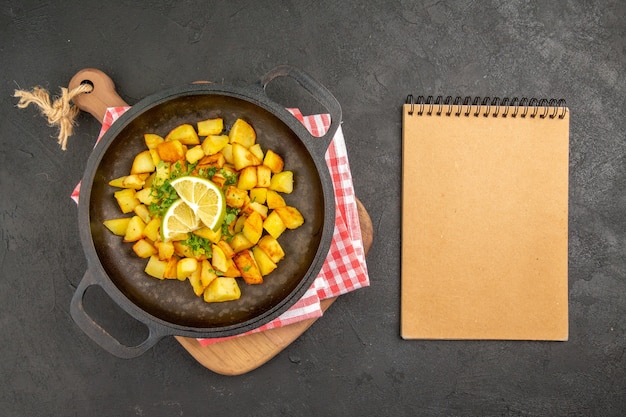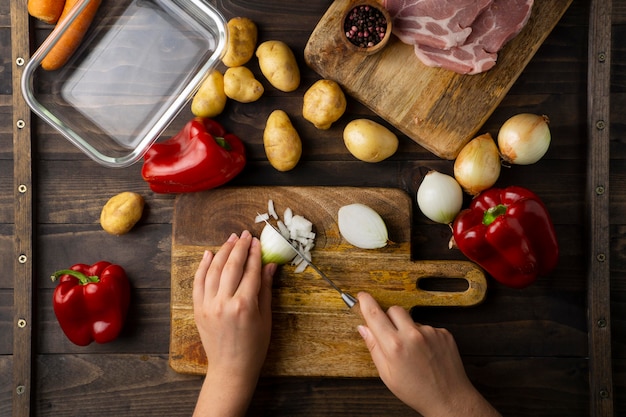Ah, potatoes! The humble spud, a culinary staple that's as versatile as it is delicious. From crispy fries to creamy mashed potatoes, there's a potato preparation for every taste and occasion. As someone who's spent years exploring the world of potato cooking, I've learned a few tricks along the way, and I'm excited to share them with you. Grab a cuppa, settle in, and let's embark on a journey of potato perfection together!
(Part 1) The Foundation: choosing the right potato

Just like you wouldn't use flour to make a cake, you need to choose the right potato for the right dish. Each variety has unique characteristics that make it ideal for specific preparations. Let's break it down:
Understanding potato types
There are three main categories of potatoes, each with its own distinct texture and flavour profile:
- Floury Potatoes: These are the fluffy superstars, boasting a high starch content that makes them perfect for mashing, roasting, and baking. Think maris piper, king edward, and Desiree. They hold their shape beautifully, creating a comforting, melt-in-your-mouth texture.
- waxy potatoes: With a lower starch content, these potatoes stay firm even after cooking. This makes them ideal for salads, boiling, and roasting when you want a bit of bite. Think Charlotte, Anya, or the ever-popular New Potato.
- all-purpose potatoes: These are the versatile workhorses of the potato world. They can handle a variety of cooking methods and make a decent side dish for most meals. Look for Red Bliss or Yukon Gold, both known for their creamy texture and subtle sweetness.
Remember, experimenting is key! Don't be afraid to try different varieties and see what you like best. You might discover a hidden gem among the many wonderful potato varieties out there.
(Part 2) Prep Like a Pro: Getting Your Potatoes Ready

Now that you've chosen your potatoes, it's time to prep them like a pro. This stage is crucial for achieving optimal results.
Washing and Peeling: A Clean Start
First things first, give your potatoes a thorough scrub under cold running water. This removes any dirt or debris, ensuring a clean start. Now, depending on your recipe, you might need to peel them. For roasted potatoes, I usually leave the skins on; they add a rustic charm and a delightful layer of flavour. However, if peeling is necessary, use a sharp knife and be careful, especially if you're a bit clumsy like me!
Cutting and Slicing: Precision Matters
Next, it's time to cut them into the size and shape required for your chosen dish. For fries, aim for long, thin strips. For mashed potatoes, I prefer to cut them into chunks, ensuring even cooking. When roasting, I usually leave them whole or cut them into wedges, depending on the size of the potatoes and the desired effect.
Here's a tip: consistency is key! If your potatoes are cut unevenly, some will cook faster than others, leading to an uneven result. Take your time and ensure all your cuts are as similar as possible. This will guarantee a beautifully cooked and evenly textured dish.
(Part 3) The Art of boiling potatoes: A Simple Yet Essential Technique

Boiling is a classic potato cooking method, and it's remarkably easy to master. It's the foundation for many potato dishes, including mashed potatoes and potato salads.
Boiling Basics: Bringing Water to a Boil
Fill a large pot with cold water and add a generous pinch of salt. This seasons the potatoes and prevents them from sticking together. Bring the water to a rolling boil over a high heat.
Adding the Potatoes: A Gentle Touch
Gently add the potatoes to the boiling water and reduce the heat slightly. Cook them for about 10-15 minutes, or until tender when pierced with a fork. Remember, different types of potatoes will cook at different speeds, so keep a close eye on them.
Draining and Serving: Timing is Everything
Once the potatoes are cooked, drain them in a colander. Don't overcook them; this will turn them into a mushy mess. You want them to be firm yet tender. Now they're ready to be mashed, added to a salad, or enjoyed on their own, depending on your chosen recipe.
(Part 4) roasting potatoes: A Side Dish of Dreams
Oh, roasted potatoes! The mere thought of them makes my mouth water. Crispy on the outside, fluffy on the inside, and bursting with flavour, they're the epitome of a satisfying side dish.
Preparing for Roasting: A Flavorful Foundation
First, preheat your oven to 400°F (200°C). Toss your potatoes with olive oil, salt, pepper, and any other herbs or spices you fancy. I love using rosemary, thyme, or paprika for a vibrant touch. Spread them out on a baking sheet in a single layer, making sure they're not crowded, allowing for even roasting.
Roasting to Perfection: Crispy and Golden
Roast them for about 30-40 minutes, flipping them halfway through. You'll know they're done when they're golden brown and crispy. If you're feeling adventurous, add some garlic cloves or onions to the pan for a boost of flavour. They'll caramelize beautifully, adding another dimension of deliciousness.
Tips for Success: Roasting Secrets
Here are a few tips to help you achieve truly exceptional roasted potatoes:
- Don't overcrowd the baking sheet. This will steam the potatoes instead of roasting them, resulting in a soggy texture.
- Use a good quality olive oil. It will make a world of difference in both flavour and texture.
- Don't be afraid to experiment with different herbs and spices. Let your creativity run wild!
- Serve them hot and enjoy!
(Part 5) The Magic of Mashed Potatoes: comfort food Perfection
Mashed potatoes are the ultimate comfort food. Creamy, fluffy, and oh-so-satisfying, they're the perfect companion to any meal.
Boiling for Mashing: The Right Consistency
Start by boiling your potatoes until they're tender, as we discussed earlier. Don't overcook them, or they'll become mushy. Drain them well and let them steam for a few minutes to remove any excess moisture.
Mashed Potato Techniques: Hand-Mashed vs. Machine-Assisted
There are two main methods for mashing potatoes, each with its own advantages:
- Hand Mashing: This is the traditional method, creating a rustic, slightly chunky texture that many find comforting. Simply mash the potatoes with a potato masher until they reach your desired consistency.
- Using a Food Processor or Mixer: For a truly creamy consistency, use a food processor or a hand mixer. Just be careful not to over-process them, or they'll become gluey. A few pulses is all you need for a smooth and silky texture.
Seasoning and Enhancing: Elevating Flavour
Once the potatoes are mashed, it's time to season them and add your personal touch. Start with salt and pepper, then incorporate other ingredients to elevate the flavour. Here are a few ideas to get your creative juices flowing:
- Butter: A classic addition that adds richness and creaminess, enhancing the natural flavour of the potatoes.
- Milk or Cream: Adds moisture and a silky texture, making the mash incredibly smooth and luxurious.
- Garlic: A flavourful addition that pairs beautifully with most dishes.
- Cheese: A cheesy mash is a real treat! You can use cheddar, mozzarella, or even blue cheese for a bolder flavour profile.
Remember, you can always adjust the seasoning to your liking. Taste as you go, and don't be afraid to experiment until you achieve the perfect flavour balance.
(Part 6) french fries: A Global Favourite
Who doesn't love a good plate of French fries? They're crispy, salty, and oh-so-satisfying, a global favourite for a reason.
Cutting and Soaking: The Secrets to Crispiness
The secret to perfect fries lies in the cut and the soak. Cut your potatoes into long, thin strips, aiming for a uniform thickness. Then, soak them in cold water for at least 30 minutes. This helps to remove excess starch, preventing them from sticking together during frying.
Double-Frying: Achieving Ultimate Crispness
For the ultimate crispiness, double-frying is the way to go. It's a bit more involved, but the results are worth the extra effort. First, fry them at a lower temperature (around 325°F/160°C) for about 5 minutes. This cooks them through without making them brown. Remove them from the oil and let them cool slightly. Then, fry them again at a higher temperature (around 375°F/190°C) for 2-3 minutes, until they're golden brown and crispy.
Seasoning and Serving: Adding the Finishing Touches
Season your fries with salt and pepper, or get creative with other spices like paprika, garlic powder, or even chilli powder. Serve them hot, with a side of ketchup, mayonnaise, or your favourite dipping sauce.
(Part 7) Beyond the Basics: Other Potato Delights
There's a whole world of potato recipes beyond mashed potatoes, roasted potatoes, and fries. Here are a few other ideas to inspire you, from the simple to the more elaborate:
Potato Salads: summertime classics
Potato salads are a classic summer side dish, perfect for picnics and barbecues. They can be as simple or as complex as you like. You can make them with boiled potatoes, mayonnaise, mustard, and other ingredients like celery, onions, or pickles.
potato soups: Comforting and Delicious
Potato soup is a comforting and delicious meal, perfect for a chilly evening. You can make it with creamy milk or broth, and add other ingredients like carrots, celery, and herbs for added flavour and texture.
potato pancakes: Crispy and Satisfying
Potato pancakes are a crispy and satisfying treat, often served as a side dish or as a light meal. They're made with grated potatoes, flour, and eggs, and they're often served with sour cream or apple sauce.
potato gratins: Decadent and Creamy
Potato gratins are a creamy and decadent dish, perfect for a special occasion. They're made with thinly sliced potatoes, cheese, and often cream or milk. They're baked in the oven until golden brown and bubbly, creating a delightful dish that's sure to impress.
(Part 8) Potato Storage and Handling: Keeping Your Potatoes Happy
Now, let's talk about how to keep your potatoes happy and healthy so they're ready for their culinary adventures.
Storage Tips: Cool, Dark, and Dry
Store potatoes in a cool, dark, and dry place, away from direct sunlight. Don't refrigerate them; this can cause them to become sweet and mushy. The ideal storage temperature is between 45°F and 55°F (7°C and 13°C).
Handling Potatoes: Washing and Soaking
Wash potatoes before cooking, but don't soak them for too long. Soaking can make them mushy. A quick rinse under cold water is usually sufficient.
Signs of Spoilage: Discarding Damaged Potatoes
Look for any signs of spoilage, such as sprouting, greening, or soft spots. If you find any of these, it's best to discard the potato.
FAQs
Let's answer a few common questions about potatoes:
1. Why do potatoes turn green?
Potatoes turn green when they're exposed to sunlight. This is due to the production of chlorophyll, the same pigment that gives plants their green colour. Green potatoes can be bitter and toxic, so it's best to avoid eating them.
2. What's the best way to peel potatoes?
For a quick and easy peel, I like to use a potato peeler. You can also use a sharp knife, but be careful not to cut your fingers.
3. How do I know if potatoes are cooked?
You can test if a potato is cooked by piercing it with a fork. If it goes in easily, it's done.
4. Can I freeze potatoes?
You can freeze cooked potatoes, but they may become a bit mushy when thawed. To freeze potatoes, boil them until they're tender, then drain and cool them completely. Store them in freezer bags or containers.
5. What are some good potato recipes for beginners?
For beginners, I recommend trying roasted potatoes, mashed potatoes, or a simple potato salad. These recipes are easy to follow and forgiving, making them perfect for building confidence in the kitchen.
And there you have it, a comprehensive guide to cooking potatoes, from choosing the right variety to storage and handling. Whether you're a seasoned chef or just starting out, I hope this has inspired you to create your own potato masterpieces. Now, get out there and cook some spuds!
Everyone is watching

Prime Rib Roast Cooking Time Chart: Per Pound Guide
Cooking TipsPrime rib roast. Just the name conjures images of lavish dinners, crackling fires, and hearty laughter. It’s ...

How Long to Bake Potatoes in the Oven (Perfect Every Time)
Cooking TipsBaked potatoes are a staple in my kitchen. They're incredibly versatile, delicious, and surprisingly easy to m...

Perfect Rice Every Time: The Ultimate Guide to Cooking Rice
Cooking TipsAs a self-proclaimed foodie, I've always been a bit obsessed with rice. It's the foundation of countless cuisi...

The Ultimate Guide to Cooking Asparagus: Tips, Techniques, and Recipes
Cooking TipsAsparagus. The mere mention of this spring delicacy conjures up images of vibrant green spears, crisp and burs...

Ultimate Guide to Cooking the Perfect Thanksgiving Turkey
Cooking TipsThanksgiving. Just the word conjures up images of overflowing tables laden with delicious food, the scent of r...
